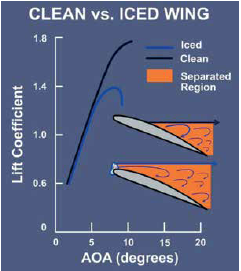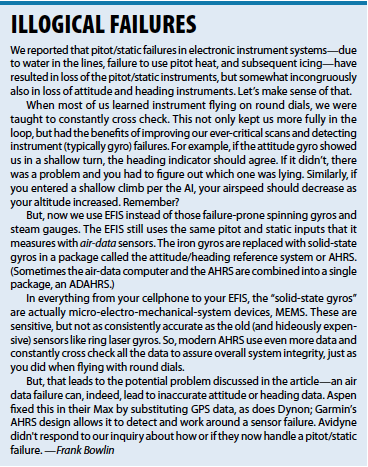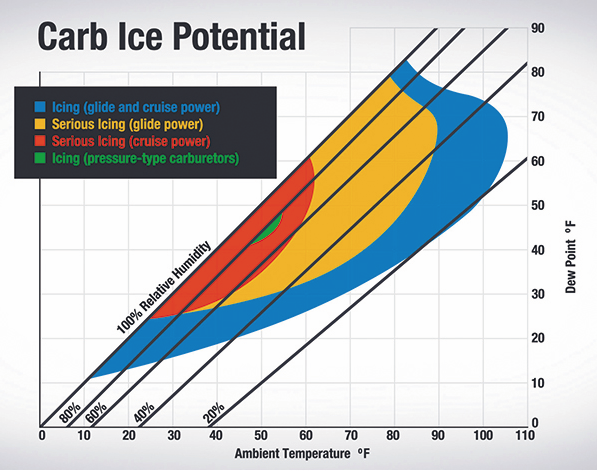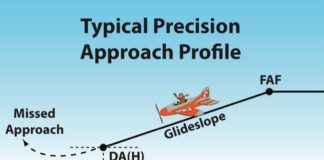Icing affects flight operations in many ways. Accordingly, we offer some thought-provoking reports from pilots who’ve been there. Little has been said about instrument malfunctions due to icing, and we discuss those in particular.
Chilly Carburetors
An instrument-rated Commercial pilot operating VFR experienced a sudden power interruption in his Cessna 150, followed by a surge and another interruption. He pumped the throttle to get intermittent power and enriched the mixture but did not apply carburetor heat. Gliding toward a diversionary airport, he activated the carb heat, but the engine was probably too cool by then for there to be enough heat left.
A full-power ground run and fuel check confirmed the problem was carburetor icing. Icing, we are taught, is gradual, and the pilot had experienced that. But a sudden, severe power loss felt more like fuel contamination or a sticking valve, so he troubleshot that instead. He later realized he had violated his own rule to apply carb heat first at the initial sign of an engine problem. He also moved the emergency checklist from the glove box to the glareshield—a smart move.
A pilot was en route IFR in a Mooney M20 in VMC when the engine began running rough during descent. To maximize his options, he immediately advised ATC. The pilot ran the emergency checklist, including “carb heat on.” Oddly, the list said if engine roughness did not improve, turn it off after one minute. The engine improved momentarily, then began losing power again. He kept trying carb heat, but the engine continued to run at 40 to 80 percent power.
After landing at a diversionary airport, the engine ran smoothly, confirmed by a normal engine runup on the ramp. Inspection revealed the butterfly valve did not move when carburetor heat was applied. It should shut completely when carburetor heat is on. Moving the control back and forth freed the butterfly valve, after which carburetor heat worked properly. Additional runups produced a larger carb heat RPM drop than earlier in the day. The pilot noted the position of the control lever with the heat fully on. The airplane flew home normally.
The pilot thought staying calm, working the checklist, and ATC’s help managing the diversion helped him focus on the problem rather than worry or succumb to fear. He recalled the runup at the beginning of the day when he noticed an RPM drop using carburetor heat but less than usual. He learned to be more alert for carburetor ice symptoms and subtle mechanical issues that might not be immediately obvious.
If something seems off, it probably is. Should something go awry, repress your emotions. Instead, focus on resolving the problem.
Pitot Heat Blues
A Mitsubishi MU-2 pilot climbed to FL200. He soon noticed his altitude was slowly decreasing, even with the autopilot and anti-icing gear on. Despite efforts to trim back to FL 200, the descent continued to FL 197. ATC confirmed he was 300 feet low. Moreover, his airspeed fluctuated between 150 to 270 knots, a strong sign of water in the system. He descended to 12,000 feet, exiting IMC. Soon the instruments began reading correctly. He canceled his emergency and landed. The problem was traced to moisture in the pitot-static system that froze at altitude. Suggestion: Always install a pitot head cover when the airplane is secured, even in a hangar.
A turbo normalized Cessna Cardinal was at FL 190 in IMC, with no ice as the OAT was -28 degrees C. The pitot heat had been on for an hour when the airspeed fell from 140 KIAS to zero, contradicting the GPS groundspeed of 175 knots. Knowing about pitot tube icing, the pilot could not reconcile an iced-up pitot tube with the heat on without airframe icing. He began to suspect the heater had failed, and a little moisture had slowly iced it up.
Climbing to FL 210 and mostly VMC, the Aspen’s primary attitude indicator and HSI failed with large red X’s and warnings screaming “ATTITUDE FAIL CHECK PITOT HEAT” and “DIRECTION INDICATOR FAIL.” The pilot could not understand why the Aspen was failing instruments unrelated to airspeed. Its altitude and VSI displays were unaffected.
Worried what might fail next, he requested a descent and diversion to a VMC airport. Once again, descending through 15,000 feet, the airspeed began to wake up on the Aspen PFD, and the Sandia backup followed seconds later as the Aspen’s ASI and HSI returned to normal. A mechanic later suspected frozen water in the pitot line.
Suggestion: Test the pitot heat during preflight or airborne by turning it on and off while watching the ammeter. Often it flickers because the heater draws lots of current. If it does, the heat works.
It’s scary that a pitot/static failure triggered unrelated illogical alarms. This inexplicable malfunction has been reported in Aspen, Avidyne, and Garmin G500 primary flight displays. Maintain your partial panel proficiency should the worst happen. (See the sidebar for more on this.)
Airframe Icing
NASA says airframe ice forms most commonly between +2 to -20 degrees C. Ice accretion can cause roll and pitch upsets due to wing and tail stalls without warning. Immediate escape is essential.
An IFR Mooney 201 at 8000 feet entered clouds. The pilot knew of an icing forecast, but all airports along the way were forecast VFR. Light rime ice began accumulating. It got worse at 6000 feet, so he climbed to 10,000 feet into VMC. On approach, the Mooney descended again to 6000 feet, the Minimum Vectoring Altitude, and ice started building again. Knowing of VFR below, the pilot advised ATC he would descend to 5000 despite the MVA. He landed safely.
Since VFR conditions did not call for an alternate, the pilot didn’t file one. He knew his terrain-following GPS would keep him clear of terrain. He added that in the future, if icing was forecast, he would fly to a different airport to exclude that possibility.
Who’s the PIC?
An ATP-rated pilot checked the weather and departed VFR in a Cirrus SR-20. His chosen route was east of a mountain range and ice-free, but his destination weather fell to 800 feet broken. He flew an ice-free RNAV approach and landed.
He then filed a return IFR flight plan for much the same route. However, the clearance routed him to the west, over the mountain range, and 2000 feet higher than filed. He accepted it.
Climbing through 6000 feet, he encountered ice. He requested a descent and return to the airport. Ice forced him to descend below the 5000-foot MEA, which soon dropped to 3400 feet. He descended to 3500 and reported he was VMC in light rain. He canceled IFR and continued to his destination.
The pilot should have refused a route he had previously rejected. A VFR-on-top clearance would have gotten him above the weather along his preferred route.
An IFR clearance is an offer, not a mandate. You can decline it and suggest a satisfactory alternative. In effect, he let ATC fly his airplane, with corresponding consequences.
AIRMET Freezes Mooney
 The instrument-rated Mooney Ovation pilot knew of an icing AIRMET. He thought he could stay below clouds until clear, then climb in VMC where temperatures were too cold for icing. But the clouds were lower, and he began accumulating trace ice around 10,000 feet. ATC cleared him to 16,000, which worked out.
The instrument-rated Mooney Ovation pilot knew of an icing AIRMET. He thought he could stay below clouds until clear, then climb in VMC where temperatures were too cold for icing. But the clouds were lower, and he began accumulating trace ice around 10,000 feet. ATC cleared him to 16,000, which worked out.
Afterward, the pilot realized he misinterpreted the satellite weather depiction of clouds and clouds with moisture sufficient to cause icing as the only places where ice could occur. This, he said, “was clearly not the case.” He credited himself for immediately enlisting ATC’s help to escape icing conditions.
Testing the Limits
Similarly, a pilot encountered icing in an area where ForeFlight did not show icing. He later wished he had consulted multiple weather sources.
Encountering MVFR, he noticed light rime icing at -20 degrees C at 14,500 feet. The pilot climbed and advised ATC he was returning to his departure airport. At 17,500 feet, it appeared he could make it safely over the top to his destination.
Thus, he wavered and decided to turn around. Soon he encountered rapid vertical cloud development. The plane began icing, and the pilot requested FL185, the aircraft’s service ceiling. His avionics flight instruments died in MVFR with pitot heat on, implying the static port was also frozen. Rusty flying on standby gauges, his oxygen tank failed, too.
The overloaded pilot retreated to just flying the airplane. Turning southwest, the weather improved, his instruments came back, and he got an IFR clearance. Back on the ground and suitably chastened, the pilot wrote ruefully, “A good preventative measure would have been not to fly at all that day.”
This narrative offers four lessons. First, use multiple sources to get the weather. Go with the one most pessimistic. Second, no flight is mandatory. Third, once decided on an alternate course of action, stick to it. Don’t doubt, dawdle, dither, or dissemble. Fourth, ice and cold find the weakest spots in your airplane and can degrade them into a cascade of malfunctions.

Super Cooled
A twin pilot encountered Supercooled Large Droplets (SLD) icing in his known-ice (FIKI) certified Piper Seneca III. He noticed “alarming” ice accretion on unprotected areas, including aft of the de-ice boots and even the side windows. Hearing rain, he turned hard left to fly out of what he now realized was heavy freezing rain.
Again, the pitot system froze despite pitot heat on as well as all de-ice/anti-ice equipment. The G500 heading, altitude, and attitude displays failed, leaving him only the standby attitude, altimeter, and compass. Switching to the alternate static source restored his airspeed but not the standby altimeter, which had also failed. He informed ATC, requesting continuous altitude readouts as he descended to escape the SLD and IMC.
He exited IMC around 4500 feet, wings level, slightly nose down. A minute after exiting cloud, the instruments came back online. The ice behind protected surfaces began melting, and he could maintain altitude and airspeed normally.
The wary pilot elected to fly straight and level for a while to ensure the aircraft was performing normally. He re-ran the cruise and severe ice checklists, finding them all normal. With ice still on the airplane, he flew his approach faster than usual without flaps and landed.
This pilot knew of SLD icing, which helped him identify it and take corrective action. He regretted assuming precipitation reported by ATC was snow. But he had been flying in snow and picked up only trace ice with an OAT of -21 degrees C. Even outside the standard temperature window for icing did not mean SLD conditions couldn’t occur. The ice nearly overcame his FIKI-certified aircraft and the pitot and stall warning heaters, which ground-tested to a toasty 205 degrees F.
Cool, not Frozen
A Cessna 172 pilot on a night IFR flight at 6000 feet with an OAT of -2 degrees C noticed precipitation bouncing off the strobes. He descended to 3000, which did not help. He diverted, but with worsening precipitation and visibility, he flew an abbreviated GPS approach directly to the FAF. ATC cleared him, and he landed safely. His calm, quick decisions saved his life.
What to Do
How much wing ice is acceptable? Well, there is some and none, and some (equivalent to medium grit sandpaper) is too much. NASA tells us that ice can increase stall speed up to 15 knots.
Apply pitot heat before entering IMC. Use carburetor heat according to the chart or at the first sign of engine roughness. Turn it on full and keep it on until the engine runs smoothly. Carb ice is possible between -7 and +38 degrees C.
Ice can freeze fuel valves, pumps, and lines. Draw fuel from all tanks before entering IMC. Build a Cold Weather preflight checklist. Practice partial panel often and use alternate static air as necessary. TKS aircraft should have oxygen available since fumes can cause mental impairment.
Coping with ice, you and ATC must act correctly and quickly because gravity, ice, and time all conspire against you. Don’t hand ice a win.






“Carb ice is possible between -7 and +38 degrees C.” I’m questioning the potential for ice at the equivalent of 100 degrees Fahrenheit.